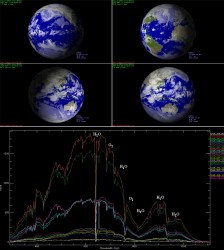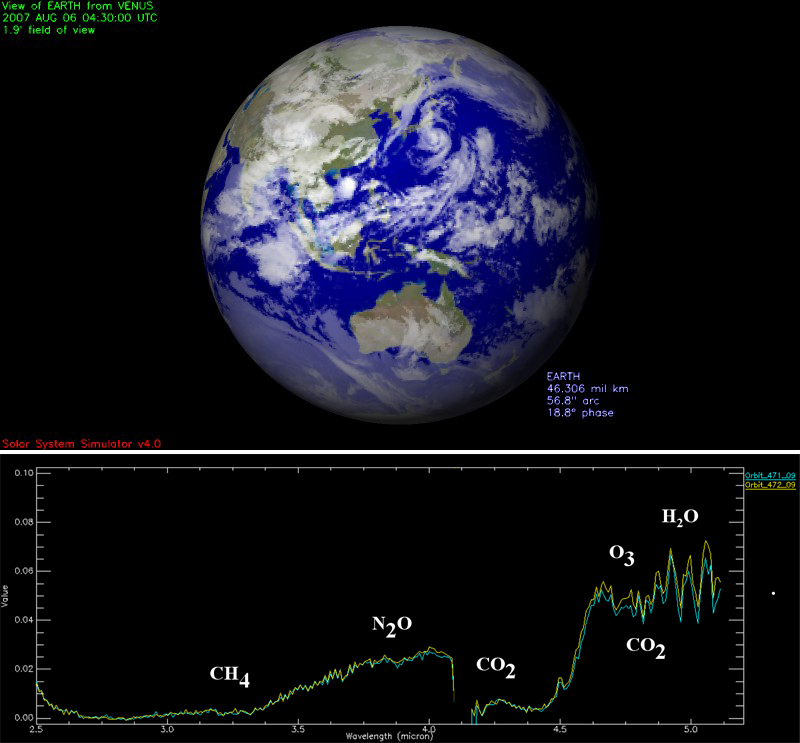[/caption]If you are an astronomer looking for a habitable exoplanet orbiting a far-off star, what do you look for? We know from personal experience that we need oxygen and water to live on Earth, so this is a good place to start; look for exoplanets with the spectroscopic signature of O2 and H2O. But this isn’t enough. Venus has oxygen and water in its atmosphere too, so if we only used these two indicators as a measure for habitability, we would be sorely disappointed to find a water and oxygen-rich Venus-like world which has little chance of supporting life (as we know it).
In an effort to understand what a “habitable planet” looks like from afar, European Space Agency (ESA) scientists have decided to do a bit of retrospective astronomy. Venus Express, currently in orbit around Venus, is being used to look back at the blue dot we call home to help us understand what a real habitable planet looks like…
Venus Express (sister ship of ESA’s Mars Express) was launched in November 2005 to begin its seven month journey to Venus. As the spacecraft left Earth orbit, it turned around to take a picture of the blue globe with its Visible and Infrared Thermal Imaging Spectrometer (VIRTIS), but the significance of this quick observation wasn’t realised until a year after Venus Express had entered Venusian orbit. Could the robotic craft be used to watch the Earth from afar?
Giuseppe Piccioni, Venus Express VIRTIS Co-Principal Investigator, in Italy, has been heading a sustained campaign of Earth observations using the VIRTIS instrument orbiting a planet 0.3 AU closer to the Sun. Although Venus has often been referred to as “Earth’s sister planet” the difference couldn’t be more stark. With atmospheric pressures some hundred times that of the Earth, with a choking cocktail of poisonous gases and high surface temperatures, Venus is hardly conducive for life. Earth, on the other hand, has a bountiful ecosystem where life has thrived for over three billion years. However, Piccioni is aware that if viewed from a distance, both Earth and Venus contain some of the basic ingredients for life; how can we be sure distant exoplanets are more Earth-like or more Venus-like? After all, planet habitability doesn’t seem to depend on just oxygen and water.
“We see water and molecular oxygen in Earth’s atmosphere, but Venus also shows these signatures. So looking at these molecules is not enough,” says Piccioni. So, in an attempt to seek out other forms of life, the Italian astronomer is looking toward Earth to pick out more subtle signals for the presence of life on alien worlds.

Although there are no surface features, this small dot still holds a lot of information. By splitting the light observed into its component wavelengths, the composition of the terrestrial atmosphere can be analysed. Therefore, spectroscopic signals from plant life could be detected for example. “Green plants are bright in the near infrared,” said David Grinspoon, a Venus Express Interdisciplinary Scientist from the Denver Museum of Nature & Science, Colorado, who suggested the programme of sustained Earth observation. “We want to know what can we discern about the Earth’s habitability based on such observations. Whatever we learn about Earth, we can then apply to the study of other worlds,” he added.
Exoplanet hunters are finding more and more alien worlds orbiting stars many light years away, it is only a matter of time before we have the technological ability to image the one-pixel spot of an Earth-like world. By understanding how our habitable planet looks from Venus, we can begin to understand whether these exoplanets are indeed “Earth-like” in every sense of the word…
Source: ESA
Here’s an article about the famous blue dot image of Earth.


Oddly enough, fire — i.e., ordinary combustion of carbon-based substances in an atmosphere with plenty of oxygen — is an indicator not just of the possibility of life, but the certainty that a world has a biosphere filled with living creatures, many of whom live on land, and that that world has an oxygenated atmosphere. Only life on land produces substances that can burn, e.g, the tissues of plants; and only in a richly oxygenated atmosphere can fire occur. So if we observe the products of combustion — carbonaceous particulates and, simultaneously, increased CO2 levels, a higher than average temperature, etc. — in the atmosphere of a world, you can bet there’s life on that world, and that it has an oxygenated atmosphere. This will never be true of Venus, at least if we don’t terraform her (after pulling her back from the fire and into a larger orbit around the Sun) or build domed habitats on her inhospitable surface that can simulate a pleasant terrestrial home. You’d have to view a world for a while, maybe for a year or longer, to be sure there is no combustion occurring in it — without creatures that have a technology of fire, using fire as its most powerful tool for shaping its environment to its satisfaction, only lightning and, much more rarely, volcanoes could touch off a fire large enough to make its presence known to a probe at any distance. But if you detect combustion products in a world’s atmosphere, you can be sure it has life, and land-life, at that.
Neato! I wonder what other more distant probes we could do this with. Could any of this be done with information from Voyagers 1’s famous Pale Blue Dot?
Venus’ orbit is just fine. It needs to be sped up in rotation, and it needs its rotational axis straightened up. Also, it needs a moon. Then, the magnetosphere will appear (after the core gets up to speed and the atmosphere will sort out itself too. Maby in 1000 years we’ll have the technology to do that. Who knows.
ahm, are you guys all Experts?
I didnt even know that.. but in 1000 years?
we will be all dead with the Global temperature.. Maybe at 2100, we will be all burned, because the temperature of the Earth is near 550ppm, some scentists says that we are more than that, but if we reach 550, e we will damned.. And with the problem of oil, we won´t be able to stop it.. Even if we stop now, we wouldnt be in time… So, we will need a good tecnology, in like 50 years, or we will be all burned..
See ya
apidcloud put down the peace pipe. 50 years? typical chicken-little environmentalist
Brilliant @ article.
Huh @ Apidcloud?
I’d like to ecco The Occupant’s suggestion.
Could we do this with any of the Mars sattellites too? Or Messenger? It’d be nice to get some appreciation of how the signal might decay with distance, even if it’s orders of magnitudes smaller than what’ll be needed for exoplanets.
Voyager’s too dead by now, but perhaps Cassini could be tried. That might even allow for looking at what happens when Earth passes in front of the Sun, emulating what’ll happen with exos.
why you say that troglodyte?
Am I a chicken?
..
what did I say wrong?
Farewell